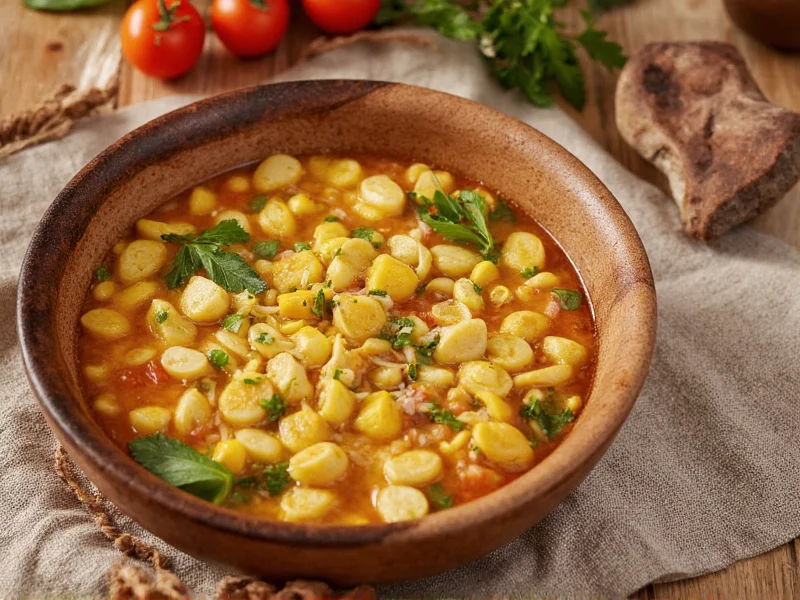Soups represent one of humanity's oldest culinary traditions, evolving from simple boiled combinations to sophisticated culinary creations across global cultures. The fundamental principle remains consistent: extracting maximum flavor and nutrition from available ingredients through slow cooking in liquid. This versatility explains why soups remain a dietary staple worldwide, adapting to local ingredients, seasonal changes, and nutritional requirements.
Global Soup Traditions and Varieties
Soup preparation reflects cultural identity and available resources. Each region has developed distinctive soup traditions that tell stories of climate, agriculture, and historical influences. Japanese miso soup demonstrates umami mastery with fermented soybean paste, while West African peanut soup combines groundnuts with vegetables and spices in a rich, hearty preparation. French cuisine features bisque (creamy shellfish soup) and bouillabaisse (Provençal fish stew), while Latin American cultures embrace hearty bean-based soups like feijoada.
| Region | Signature Soup | Key Ingredients | Cultural Significance |
|---|---|---|---|
| East Asia | Miso Soup | Fermented soybean paste, seaweed, tofu | Served daily with meals in Japan, represents harmony |
| Mediterranean | Minestrone | Seasonal vegetables, beans, pasta, tomato | "Everything soup" using available garden produce |
| Mexico | Caldo de Pollo | Chicken, vegetables, garlic, cilantro | Traditional remedy for illness, family comfort food |
| Eastern Europe | Borscht | Beets, cabbage, potatoes, sour cream | Symbol of Ukrainian heritage, often served with bread |
Nutritional Benefits and Considerations
Well-constructed soups offer exceptional nutritional value through concentrated vitamins, minerals, and hydration. Vegetable-based soups provide fiber and phytonutrients while typically remaining low in calories. Bone broths deliver collagen and amino acids that support joint health. When preparing healthy soup recipes for winter, focus on seasonal vegetables like squash, root vegetables, and dark leafy greens that provide essential nutrients during colder months.
The nutritional benefits of vegetable soup increase when prepared with minimal processing. Roasting vegetables before adding to broth enhances flavor without requiring excessive salt. For those monitoring sodium intake, using homemade broth instead of commercial varieties significantly reduces sodium content while maintaining rich flavor. Adding a splash of acid (lemon juice or vinegar) at the end brightens flavors and improves mineral absorption from vegetables.
Mastering Soup Preparation Techniques
Successful soup making follows several fundamental principles that transform ordinary ingredients into extraordinary meals. Traditional soup preparation methods begin with building flavor layers through techniques like sweating aromatics (onions, celery, carrots) without browning, known as a mirepoix in French cuisine. The order of ingredient addition matters significantly—denser vegetables require longer cooking times than delicate greens.
For optimal texture in pureed soups, use an immersion blender directly in the pot rather than transferring hot liquid to a countertop blender. When incorporating dairy into soup, temper it by slowly adding small amounts of hot broth to prevent curdling. The best ingredients for homemade soup always include fresh, seasonal produce and quality protein sources. Never boil soup vigorously after adding delicate ingredients like pasta or seafood, as this breaks down textures and cloud the broth.
Seasonal Soup Planning and Storage
Understanding seasonal soup recommendations ensures you're using ingredients at their peak flavor and nutritional value. Spring soups feature asparagus, peas, and fresh herbs. Summer brings gazpacho and chilled cucumber soups that require no cooking. Fall soups showcase pumpkin, squash, and apple combinations. Winter demands hearty bean soups, stews, and bone broths that provide warmth and sustained energy.
Proper storage and reheating guidelines maintain soup quality and safety. Cool soup rapidly by placing the pot in an ice bath before refrigerating. Store in airtight containers for up to four days in the refrigerator or freeze in portion-sized containers for up to three months. When reheating, bring soup to a rolling boil for one minute to ensure food safety, then reduce to serving temperature. Add fresh herbs and a finishing touch like a drizzle of good olive oil just before serving to revitalize flavors that may have mellowed during storage.
Frequently Asked Questions
What's the difference between broth, stock, and consommé?
Broth is made with meat and vegetables, simmered briefly for immediate flavor. Stock uses bones with minimal meat, simmered longer (4-6 hours) to extract collagen. Consommé is a clarified broth where egg whites trap impurities, creating a crystal-clear liquid with intense flavor.
How can I thicken soup without flour or cornstarch?
Natural thickening methods include blending part of the soup, adding pureed beans or lentils, incorporating cooked rice or potatoes, or simmering uncovered to reduce liquid. Root vegetables like parsnips and sweet potatoes also release natural starches that thicken soups as they cook.
Why does my soup taste flat after refrigeration?
Flavor compounds temporarily bind with starches and proteins during cooling, reducing perceived taste. Always re-season soups after refrigeration—a splash of acid (lemon juice or vinegar), fresh herbs, or a pinch of salt can dramatically improve flavor. Heating also releases trapped flavor compounds back into the liquid.
What are the best practices for freezing soups?
Cool soups completely before freezing. Leave 1-inch headspace in containers for expansion. Portion into meal-sized containers for easy thawing. Soups with potatoes, pasta, or dairy don't freeze well as these ingredients change texture. Label containers with date and contents. Most soups maintain quality for 2-3 months in the freezer.
How do I prevent my cream-based soups from curdling?
Prevent curdling by tempering dairy—slowly add small amounts of hot soup to the dairy while whisking, then combine. Never boil cream soups. Add dairy at the end of cooking when soup is below boiling point. For extra stability, create a liaison by mixing egg yolks with cream before tempering into the soup. Acidic ingredients can also cause curdling, so balance tomatoes or wine carefully.











 浙公网安备
33010002000092号
浙公网安备
33010002000092号 浙B2-20120091-4
浙B2-20120091-4